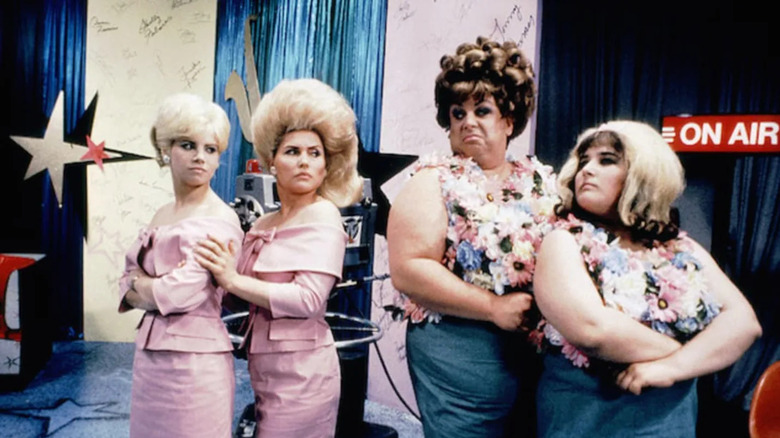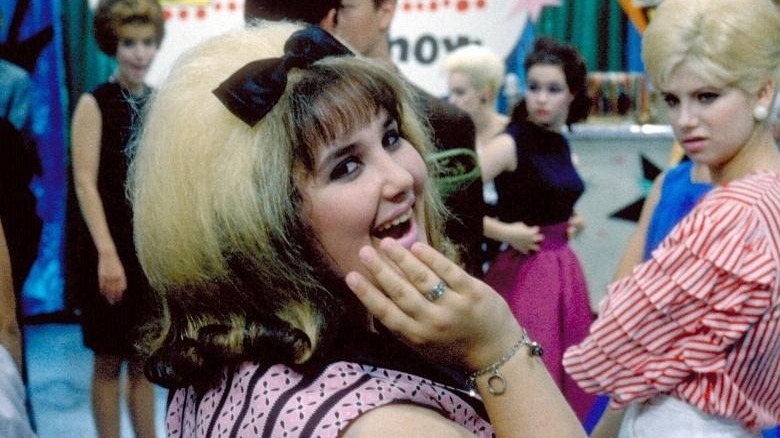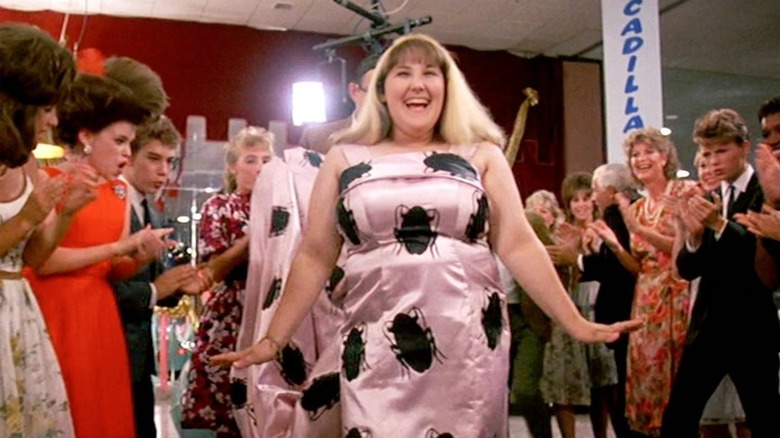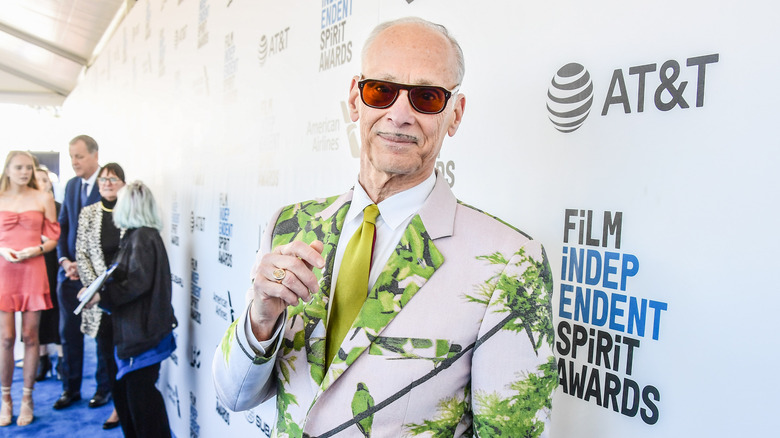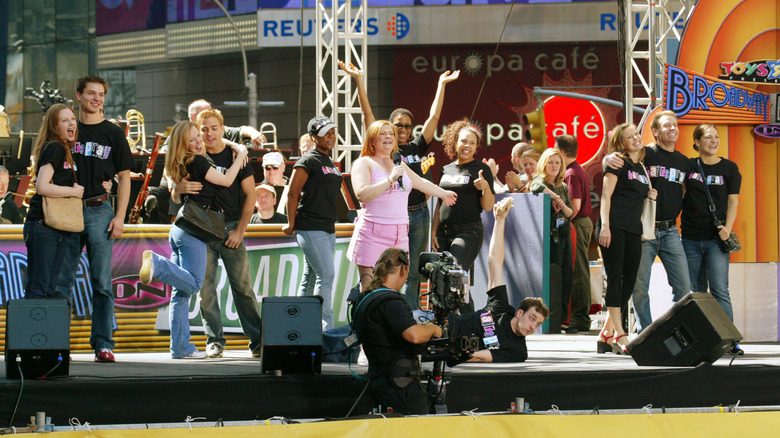35 Years Of Hairspray, John Waters' Cleanest Film
John Waters, the Pope of Trash, made his most mainstream and family-friendly movie with 1988's "Hairspray" — but did so without diluting his outsider essence.
You don't get to be known as the Pope of Trash without seriously proving yourself over the decades. Having started with creatively titled short films like "Hag in a Leather Jacket" in the '60s, director John Waters slowly established himself as a thoroughly unique director of proud, all-American filth. He dominated the '70s midnight movie circuit thanks to attention-grabbing exploits like "Multiple Maniacs," "Female Trouble," and the infamous "Pink Flamingos." No director seemed less likely to penetrate the mainstream than Waters, a man whose works included singing anuses, feces eating, rape via giant lobster, and penis removal. Yet it happened in 1988 when Waters made "Hairspray."
The unthinkable occurred when Waters directed a film with big stars, a family-friendly rating, and a solid box office return, one big enough to give it the status of a hit. Gene Siskel and Roger Ebert, who both hated earlier Waters films, gave it positive reviews. Rolling Stone described it as "a family movie both the Bradys and the Mansons could adore" (this was Waters' favorite review of the movie.) It's not unheard of for an outsider artist to break into the cozy mainstream. Nowadays, it's essentially the status quo for indie talents to jump straight into franchise blockbusters after one or two films. Waters, however, was an especially unique example. He came to the forefront of audiences' imaginations without divorcing himself from what made people so shocked by him in the first place. "Hairspray" may be family-friendly but it's still John Waters doing what he does best.
The true-life origins of Hairspray
"Hairspray" takes place, as all Waters films do, in his home city of Baltimore. Waters took inspiration from the real-life Buddy Deane Show, a local dance party program that ran from 1957 to 1964 in the Maryland area. That show featured local teens who danced to the hits of the era, although the entire cast was white except for one episode every other Friday for Black kids. The series was taken off the air when its home station, WJZ-TV, wouldn't allow the Black and white dancers to integrate, even as the host played the kind of modern music that other channels deemed to be "too Black."
In Waters' version, the series is called the Corny Collins Show, and our heroine is the pleasantly plumb and vivacious teen Tracy Turnblad, played by a young Ricki Lake. As she gains city-wide fame and the staid locals reject her modern attitudes, she befriends her Black classmates who are unable to dance on the show aside from its monthly "Negro Day" episode. Soon, Tracy becomes an unlikely advocate for desegregation. It's the most toe-tappingly charming film about racial integration ever made!
How Hairspray mocks '50s nostalgia
In the 1970s and '80s, there was a major glut of pop culture offering a nostalgic glance back at the 1950s. Think of shows like "Happy Days" or movies like "Grease", where the prevalent "cool" image of the time became the stuff of retro chic. The works of Stephen King, especially the terrifying doorstopper "IT", offered a more skeptical look at the decade and how the aesthetic trappings concealed a bleak era of paranoia and cruelty. It's common practice for nostalgia to strip something of its harsher truths in favor of a more marketable style or cycle of tropes to be sold on to younger generations. Consider how the likes of "Grease" are entirely white and don't even hint at the civil rights tensions of the time, even as they appropriate Black-pioneered music for their own means.
For Waters, nostalgia is something to cherish but not blindly. The clothes and the bouffant hairdos are all fabulous, but in "Hairspray" they are used to disguise callous hatred towards Baltimore's Black population. The racist von Tussle family, played to the hilt by Debbie Harry and Sonny Bono, try to sabotage a major event with a bomb hidden in their giant beehive 'do. The Corny Collins Show is a giant advertisement for whiteness and "good old-fashioned values", even as some deride it as "delinquency" because they dance to Black music. It's a savvy, if somewhat simplistic, reminder that pop culture was and has always been a crucial tool in shaping the societal attitudes of younger generations.
How John Waters became mainstream
Nowadays, Waters is almost respectable. He's a talk-show regular, a New York Times best-selling author, and a patron of the arts (the toilets of the Baltimore Museum of Art are named after him thanks to a substantial donation of paintings he made from his personal collection.) Films that once infuriated the critical elite are now in the Criterion Collection, and "Pink Flamingos" is listed at number 211 on the most recent Sight and Sound list of the 250 greatest films of all time (it's ahead of "Star Wars" and "A Clockwork Orange"!). "Hairspray" is also the stuff of the mainstream now, thanks to a wildly successful Broadway musical adaptation, which later became its own film. High schools now perform John Waters jokes, which is a beautiful thing to think about.
Yet all of this happened without John Waters giving up everything that makes him John Waters. The success of "Hairspray" saw him become a part of the decade's burgeoning indie movie boom, giving him wider releases and bigger budgets. Some critics found titles like "Pecker" and "Cecil B. Demented" to be watered-down Waters, but his work still championed weird outsiders and a total rejection of societal norms. It's not simply that he dismissed normalcy, however that may be defined, but that he reinvented the notion of good old American family values to fit the kinds of people they were designed to exclude. "Hairspray" is one of his most direct versions of this philosophy, spitting in the eye of rose-tinted nostalgia and widening the vision to make it more inclusive. It's wholesome in its own weird, bomb-heavy way, and it's never gone out of style, even as Waters evolved into the cool weird uncle of indie film.
How does Hairspray stand 35 years later?
When people talk of "Hairspray" today, they're probably thinking more about the Broadway musical, which won eight Tony Awards and ran for seven years, and its subsequent film version starring John Travolta. It's a very fun musical full of absolute bops and it's easy to see why it took off with tourist crowds and has received countless international productions. It retains much of Waters' dialogue but the viewing experience is very different. There's a facetiousness to Waters' dialogue, a heightened sense of reality that feels more at home in a soap opera or Douglas Sirk melodrama than a family comedy. There are stoned beatniks and explosives and a quack doctor who tries to brainwash a teenage girl into only being sexually attracted to white boys. The musical, by comparison, is 100% earnest, right down to its stirring 11 o'clock musical number "Know Where I've Been." Ultimately, "Hairspray" the musical isn't very Waters-esque, even with some of his funniest lines intact.
Some have criticized the naivety of Waters' narrative, one where a white colorblind teen who just wants to dance kicks off a civil rights storm more potent than that of Baltimore's sizeable Black populace. The film is aware of its limitations and mocks Tracy for her sudden elevation to a wannabe Martin Luther King. None of that is present in the stage show, and the end result is an even more diluted happy-ever-after take on history that is heart-warming, to be sure, but devoid of the prickliness that Waters has refused to sacrifice. A mockery of nostalgia becomes a piece of nostalgia. This doesn't weaken the source material, but it does reveal the ways that pop culture has always operated, constantly watering down the most powerful details in favor of palatability for an assumed white-majority audience. Perhaps that's why Waters became respectable: audiences were paying attention to the wrong "Hairspray."
